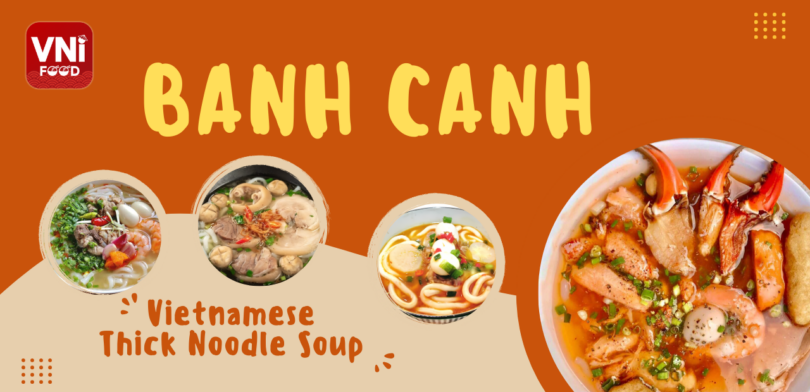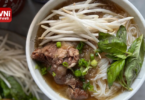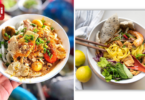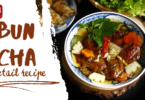Exploring Banh Canh: Vietnamese Thick Noodle Soup
Banh Canh is a traditional Vietnamese noodle soup renowned for its thick, chewy noodles and flavorful broth. Originating from Central Vietnam, it typically features a savory broth made from pork, crab, shrimp, or fish, combined with fresh herbs and spices. The noodles, crafted from a blend of rice and tapioca flour, provide a unique texture that sets Banh Canh apart from other noodle soups.
Here’s a closer look at what makes Banh Canh:
- Noodles
The noodles used in Banh Canh are made from tapioca flour, rice flour, or a combination of both. These noodles are thicker and chewier compared to the more common pho noodles. They can be cut into various thicknesses, ranging from thin strands to broad, flat noodles.
- Broth
The broth of Banh Canh varies depending on the regional and personal recipes. It can be made from pork, chicken, or seafood. The broth is often seasoned with fish sauce, sugar, and sometimes a hint of star anise, resulting in a flavorful and aromatic base.
Served hot and garnished with herbs, lime, and chili, Banh Canh is a comforting and satisfying dish beloved by locals and visitors alike. Banh Canh is often enjoyed as a comforting meal, suitable for any time of the day. It is a staple in many Vietnamese households and can be found at street vendors, casual eateries, and sometimes in more upscale restaurants.
Roots of Banh Canh

The genesis of Banh Canh is steeped in the traditions of Central Vietnamese cuisine, a melting pot of indigenous flavors and culinary techniques passed down through generations. Influenced by centuries of trade and cultural exchange, Banh Canh emerged as a culinary masterpiece, embodying the essence of Vietnamese gastronomy.
As Banh Canh traversed the length and breadth of Vietnam, it underwent a metamorphosis, adapting to the unique palates and ingredients found in each region. From the aromatic spices of the north to the fiery flavors of the south, Banh Canh evolved, becoming a canvas for culinary innovation and creativity.
Beyond its gastronomic allure, Banh Canh is a testament to the resilience of Vietnamese culture, surviving the trials of time and history. Whether served in humble street stalls or lavish feasts, Banh Canh embodies the spirit of communal dining, bringing together families and communities in celebration of shared heritage.
Different Styles of Banh Canh
Banh Canh exhibits regional variations influenced by local ingredients and traditions. In southern Vietnam, Banh Canh Cua features a creamy broth with crab meat or paste, while central regions may incorporate quail eggs for a unique twist. Northern Vietnam highlights shrimp in its clear broth, and coastal areas favor fish cake additions. In cooler regions, Banh Canh Gio Heo showcases pork hocks in a hearty broth. Urban areas experiment with fusion variations, reflecting the evolving culinary landscape of Vietnam. Each regional variation offers a taste of Vietnam’s diverse culinary heritage, from the indulgent richness of the south to the delicate flavors of the north.
Let’s delve into various types of Banh Canh throughout Viet Nam below!
Popular Varieties
1. Banh Canh Cua (Crab Banh Canh)

Crab Banh Canh boasts a perfect harmony of the rich taste of crab meat and the sweetness of crab broth. Each spoonful is imbued with the natural sweetness of fresh crab, creating a robust and distinctive flavor unique to Crab Banh Canh. Highlighted by the addition of crab meat, often carefully selected and cut into small pieces or crab balls. The broth, characteristic of this dish, typically has a deep orange color, is thick, and perfectly blends with the aroma of natural spices, creating an irresistible flavor.
2. Banh Canh Gio Heo (Pork Hock Banh Canh)

Pork Hock Banh Canh carries the distinctive taste of pork, from the robust aroma of pork hock bones to the rich tenderness of pork hock meat. The broth of this dish is usually cooked from pork hock bones for an extended period, creating a rich and special flavor. Pork Hock Banh Canh is often served with tender pieces of pork hock, cooked until infused with spices and tender. This dish is also typically accompanied by raw vegetables and pickled mustard greens to create a balance between the strong and enticing flavors.
3. Banh Canh Tom (Shrimp Banh Canh)

Shrimp Banh Canh is renowned for its light, natural sweetness derived from shrimp carcasses and the depth from shrimp bones. The flavor of the broth is often balanced between sweetness, saltiness, and a hint of light sourness, creating a perfect harmony.
Shrimp Banh Canh is usually served with fresh, delicious shrimp, either whole or sliced, creating a delicious and attractive dish. Raw vegetables and condiments like fried shallots and pepper are often added to create a rich and multi-dimensional flavor.
Other Varieties of Banh Canh
1. Banh Canh Ca (Fish Banh Canh)

Imagine a bowl brimming with Fish Banh Canh, where tender chunks of fish fillet or fish balls dance in a broth infused with the essence of the ocean. With each savory sip, experience the richness of the sea and the vibrant flavors of Vietnamese spices, promising a culinary adventure like no other.
2. Banh Canh Trung Cut (Quail Egg Banh Canh)

Elevate your dining experience with Quail Egg Banh Canh, where the richness of the broth is complemented by the elegance of whole or sliced quail eggs. With its garnishes of green onions, fried shallots, and a hint of sesame oil, this dish offers a sophisticated twist on traditional Vietnamese cuisine.
3. Banh Canh Bot Loc (Tapioca Banh Canh)

Refresh your palate with Tapioca Banh Canh, a unique variation that offers a refreshing twist on the traditional noodle soup. Instead of noodles, translucent tapioca pearls take center stage in a clear broth, allowing the flavors of minced pork or shrimp to shine through.
Nutritional Content

As a culinary expert, analyzing the nutritional composition of Banh Canh requires a nuanced understanding of its ingredients and cooking methods. While specific nutritional values may vary based on the recipe and serving size, here’s a comprehensive breakdown of the potential nutritional benefits of this Vietnamese delicacy:
- Protein Content:
- Banh Canh typically features protein-rich ingredients such as shrimp, crab, pork, eel, or fish.
- Protein is crucial for muscle repair, growth, and overall cellular function.
- Depending on the variation, a serving of Banh Canh may provide approximately 15-25 grams of protein per serving, contributing significantly to daily protein requirements.
- Carbohydrate Profile:
- The primary source of carbohydrates in Banh Canh comes from rice flour (used to make the noodles) and tapioca pearls.
- Carbohydrates are the body’s main source of energy, supporting physical and cognitive performance.
- A single serving of Banh Canh may contain approximately 30-50 grams of carbohydrates, providing sustained energy throughout the day.
- Fat Content:
- The fat content in Banh Canh varies depending on the type of meat or seafood used in the recipe.
- While fats are often demonized, they play a crucial role in nutrient absorption, hormone regulation, and cell membrane structure.
- A serving of Banh Canh may contain approximately 5-15 grams of fat, with a balanced distribution of saturated, monounsaturated, and polyunsaturated fats.
- Vitamins and Minerals:
- Banh Canh is often garnished with fresh herbs and vegetables, such as cilantro, green onions, and chili, providing essential vitamins and minerals.
- These ingredients are rich in vitamin C, vitamin K, potassium, and other micronutrients vital for immune function, bone health, and electrolyte balance.
- Consuming Banh Canh with a variety of fresh herbs and vegetables enhances its nutritional profile, contributing to overall health and vitality.
- Sodium Content:
- Some variations of Banh Canh may contain higher levels of sodium, particularly if commercial broth or seasoning is used.
- While sodium is necessary for fluid balance and nerve function, excessive intake can lead to adverse health effects such as hypertension and cardiovascular disease.
- It’s essential to monitor sodium intake and opt for homemade broths or low-sodium alternatives when preparing Banh Canh to promote heart health and overall well-being.
In summary, Banh Canh offers a harmonious blend of protein, carbohydrates, fats, vitamins, and minerals, making it a nutritious and satisfying addition to a balanced diet. By incorporating fresh, high-quality ingredients and practicing mindful cooking techniques, individuals can enjoy the flavorful delights of Banh Canh while supporting their nutritional needs and culinary enjoyment.
Serving Tips
– Preparing the Noodles
- Cook Properly: Boil the noodles until they are just tender but still chewy. Overcooking can cause them to lose their characteristic texture.
- Rinse in Cold Water: After boiling, rinse the noodles in cold water to stop the cooking process and prevent them from sticking together.
– Assembling the Dish
- Warm Bowls: Serve the soup in pre-warmed bowls to keep the dish hot for longer.
- Layering: Place the noodles in the bowl first, then add the proteins and vegetables before ladling the hot broth over everything.
– Toppings and Garnishes
- Fresh Herbs: Use fresh cilantro, scallions, and crispy fried shallots. Also, serve with pickled vegetables or fresh bean sprouts.
- Acid and Heat: Offer lime wedges, chili slices, and fish sauce for customization and for better flavor.
- Beverage: Pair with iced jasmine tea or Vietnamese iced coffee.
Final Words
In summary, Banh Canh epitomizes the culinary excellence of Vietnamese gastronomy, a testament to the meticulous craftsmanship and profound heritage ingrained in every bowl. From the delicate fragrance of its broth to the succulent textures of its ingredients, each variation of Banh Canh embodies the essence of Vietnam’s culinary artistry, meticulously honed over centuries. As we draw the curtains on this gastronomic exploration, let us carry forward the profound appreciation for Banh Canh, sharing its flavors with discerning palates worldwide and perpetuating its esteemed legacy as a culinary masterpiece cherished by connoisseurs and enthusiasts alike.








